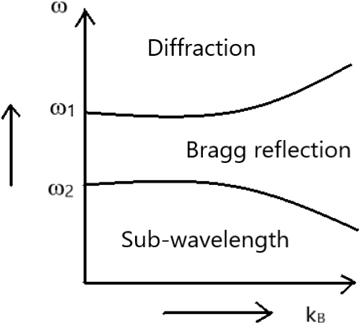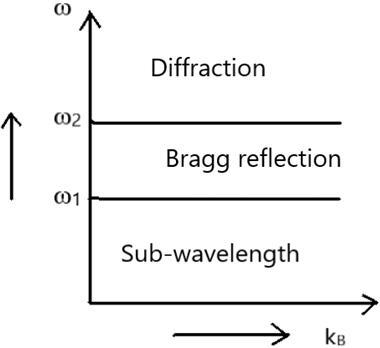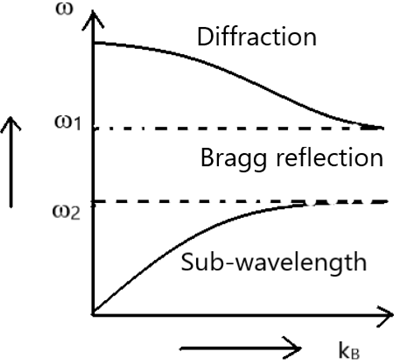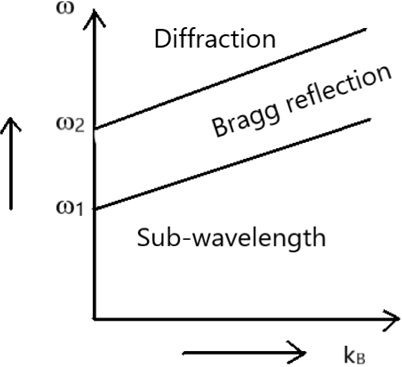This set of Nanotechnology Multiple Choice Questions & Answers (MCQs) focuses on “Nano-Optics – Photonic Crystals”.
1. What was the first ever fabricated 3D photonic crystal?
a) Yablonovite
b) Inverse opals
c) 3D OLED with square symmetry
d) Inverse colloidal crystals
View Answer
Explanation: Eli Yablonovitch released his journal on photonic crystals in 1987 and by 1991 he was able to demonstrate the first 3D photonic band gap in the microwave regime. Yalonovitch showcased a structure that had inverse cylindrical holes arranged in a diamond lattice. Today this material is known after his name as Yablonovite.
2. What is the purpose of 1D photonic crystals made of polymers?
a) Act as sensing device for bacterial contamination
b) Act as a far infrared filter
c) Act as detectors of volatile organic compounds
d) Act as low loss surface plasmons for waveguides
View Answer
Explanation: One-dimensional photonic crystals made of polymers can be used to detect volatile organic compound vapours in atmosphere. One-dimensional photonic crystals doped with bioactive metals have been suggested to act as sensors for bacterial contaminants. A novel type of 1D graphene-dielectric photonic crystal has been proposed to act as a far infrared filter and support low loss surface plasmons for sensing and waveguide applications.
3. Which of the following is not a factor on which the bandgap characteristics of 3D photonic crystals depend?
a) Dimensionality
b) Dielectric constant
c) Width of bandgap
d) Filling ratio
View Answer
Explanation: The bandgap characteristics of 3D photonic crystals depend on dielectric constant, density on the upper and lower boundary and width of bandgap. In addition to these, parameters such as filling ratio and radius of the ball also influence the bandgap variations in 3D photonic crystals.
4. Which among the following is still a theoretical application of photonic crystals?
a) Thin film optics
b) Non-linear devices
c) Lens coatings
d) Optical computers
View Answer
Explanation: Photonic crystals are attractive optical materials that control and manipulate light flow. One-dimensional crystals are used as thin- film optics with applications from low to high reflection coatings on lenses. They have also found their usage in colour changing paints and inks. Two-dimensional crystal fibres are used in nonlinear devices and to guide exotic wavelength. However, 3D counterparts are still far from commercialization which may one day be used in optical computers and photovoltaic cells.
5. Which of the following is not a challenge faced during higher dimensional photonic crystal fabrication?
a) Robust mass production of crystals
b) Prevent scattering losses
c) Control electromagnetic waves with photonic bandgap
d) Production of crystals with high precision
View Answer
Explanation: Creation of higher dimensional photonic crystals is faced with a number of challenges – a) Production of crystals requires enough precision which makes it time consuming, b) Precision is needed to prevent scattering losses blurring the crystal properties, c) Designing methods that lead to robust mass production of crystals.
6. Which of the following factor does not reduce the efficiency of a grated coupler?
a) Polarization filters
b) Penetration loss
c) Mode Mismatch
d) Back reflection
View Answer
Explanation: One of the important features of grating couplers is its coupling efficiency which can be lowered by three main factors:- (i) Penetration loss – apart of waveguide power that escapes into the substrate; (ii) Back reflection – optical power that gets reflected into the waveguide from the coupler; (iii) Mode Mismatch – overlap integral between the near-Gaussian optical fiber mode and the diffracted light beam.
7. Find out the incorrect statement regarding photonic crystals?
a) Dielectric structures that form the energy band structure for photons
b) Occur in nature in the form of animal reflectors
c) Do not affect the motion of the photons
d) The crystals are periodic optical nanostructures
View Answer
Explanation: Photonic crystals are periodic dielectric structures that form the photonic bandgap and have the capability to control electromagnetic waves. These crystals are periodic optical nanostructures that affect the motion of photons. They occur in nature in the form of animal reflectors and structural coloration.
8. Select the graph from the given options that correctly represents the k-w diagram of a 1D photonic crystal with lengthwise propagation (along X-axis).
a)

b)

c)

d)

View Answer
Explanation: From the graph it is visible that for a given pitch periodic structure, the working regime is strongly related to free space operating wavelength (λ) or the operating frequency (ω). In case ω > ω1, the waveguide becomes lossy for Bloch mode and light gets scattered out of the waveguide, and this is the diffraction regime. In the frequency range ofω2 > ω > ω1, light is reflected and the region is called the Bragg reflection regime. The last regime is located in the frequency region ω < ω1, where periodic structures work as homogeneous media.
9. Why is it essential to computationally model photonic crystal systems?
a) To design striking structural colour effects
b) To engineer location and size of bandgap
c) To avoid complex machinery of nanotechnological methods
d) To prevent scattering losses that blur crystal features
View Answer
Explanation: Photonic crystals have photonic band gap which is essentially the gap between dielectric line and the air line in the dispersion relation of the band gap system. It is recommended to model photonic crystals computationally to engineer the location and size of the bandgap. This could be done using few methods such as plane wave expansion method, finite element method, KKR method etc.
10. Opal is a natural photonic crystal.
a) True
b) False
View Answer
Explanation: Opal is an example of a naturally occurring photonic crystal. An opal crystal gives out iridescent colour owing to the natural periodic microstructures of the silica which compose the opal. The colours observed are on account of the angle of observation with respect to the opal structure. This means the same spot on opal crystal can take different colours depending on how light interacts with the structure.
Sanfoundry Global Education & Learning Series – Nanotechnology.
To practice all areas of Nanotechnology, here is complete set of 1000+ Multiple Choice Questions and Answers.
If you find a mistake in question / option / answer, kindly take a screenshot and email to [email protected]
